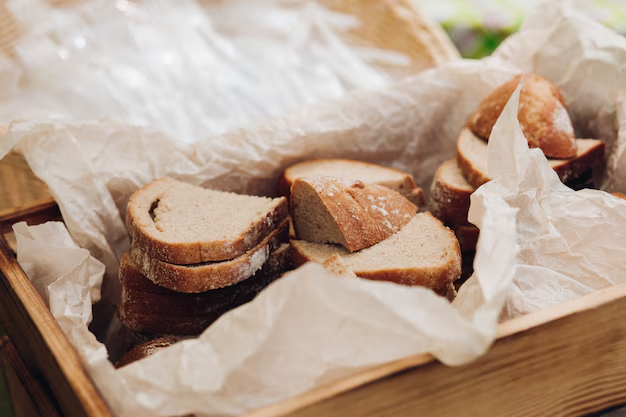Should You Store Bread in the Refrigerator? A Complete Guide
Bread is a staple in many households—a versatile food that accompanies countless meals. Yet, the debate about whether bread should be stored in the refrigerator persists. Some people swear by the fridge's ability to keep bread fresh longer, while others claim it ruins the texture and taste. So, where exactly should your bread go? In this guide, we’ll dive into the pros and cons, explore different types of bread, and provide practical storage solutions. Let’s unlock the secrets of bread storage together!
🥖 Why Bread Storage Matters
Bread storage may seem trivial, but it can significantly impact the flavor, texture, and shelf life of this everyday food. Freshness is crucial because no one enjoys a sandwich made with stale bread. But it’s not just about taste—proper storage can also play a role in minimizing waste, saving you money and trips to the grocery store.
Bread and Staling: The Science Behind It
Staling is the process that makes bread hard and dry. When bread is exposed to air, it loses moisture, leading to a stale texture. Interestingly, refrigeration accelerates this process because it encourages the recrystallization of starch molecules. In simpler terms, bread goes stale faster in the fridge. However, it's essential to weigh this against the risk of mold growth in warmer environments.
🍞 Types of Bread and Their Storage Needs
Different breads have different needs. Here's a look at how to store various types effectively:
1. White and Whole Wheat Bread
- Store at Room Temperature: These breads generally keep well in a breadbox or a sealed plastic bag on the countertop, lasting about 3–5 days.
- Refrigeration Consideration: Refrigerating can extend the life but often at the expense of flavor and texture.
2. Sourdough Bread
- Store at Room Temperature: Given its crusty exterior, sourdough can last longer than other types without refrigeration, usually up to a week.
- Freezer Option: Slice before freezing for easy, single-serve use. This is an excellent method to preserve taste and freshness without staling issues.
3. Rye Bread
- Store at Room Temperature: Rye bread’s dense texture helps it last longer. A sealed container at room temperature is ideal.
- Freezer-Friendly: Like sourdough, rye bread freezes well.
4. Gluten-Free Bread
- Refrigerate: Gluten-free bread often contains perishable ingredients that require cooler storage conditions.
- Freeze for Longer Life: Slice and freeze for longevity and convenience.
🥯 How the Refrigerator Affects Bread
Refrigerating bread can be both helpful and detrimental. Let’s take a deeper look at the effects:
Pros of Refrigerating Bread
- Mold Prevention: Cooler environments can slow down mold growth, a common issue in warmer climates.
- Extended Shelf Life: If you won't use the bread soon, the fridge may extend its edibility, albeit with textural changes.
Cons of Refrigerating Bread
- Accelerated Staling: Bread’s texture can become stiff and dry in the refrigerator due to quicker moisture loss.
- Flavor Changes: The fridge can sometimes dull flavors, particularly in varieties like sourdough and artisan loaves.
🚫 When Not to Refrigerate Bread
While there are scenarios where the fridge might be useful, here are instances when you'll want to steer clear:
- Immediate Use: If you plan to consume the bread within a couple of days, room temperature is best.
- Type and Quality Considerations: Freshly baked artisan breads often taste best when left out but stored properly in a breadbox or bag.
🏠 Best Practices for Bread Storage
Here's how to strike the right balance and keep your bread fresh and tasty:
Room Temperature Tips
- Use a breadbox, cloth bag, or a wrapped towel for short-term storage.
- Keep bread away from sunlight and heat sources to prevent mold.
Freezer Storage Techniques
- Slice Before Freezing: Makes thawing easier and quicker, allowing you to toast straight from the freezer.
- Double Wrap: Use plastic wrap and a freezer bag for better protection against freezer burn.
- Label with a Date: To ensure you know the loaf’s vintage and use it in a reasonable time frame.
🍽️ Quick Tips for Optimal Bread Enjoyment
- Revive Stale Bread: A few minutes in the oven or a quick round in the toaster can bring bread back to life.
- Pair with Meals: Plan meals that require bread, like sandwiches or toast, to ensure you’re using your stock efficiently.
- Bread-Only Strategy: Try purchasing just enough bread to match your consumption habits.
📋 Quick Summary & Tips
For those needing a condensed version, here's a handy guide:
| Bread Type | Best Storage Method |
|---|---|
| White/Whole Wheat | Room Temp (3–5 days), Fridge for mold issues |
| Sourdough | Room Temp up to 7 days or slice and freeze |
| Rye | Room Temp or freeze for extended storage |
| Gluten-Free | Refrigerate or freeze if not used quickly |
Takeaways:
- 🥖 Room Temp: Best for flavor, short-term storage.
- ❄️ Freezing: Maintains texture and freshness long-term.
- 🚫 Avoiding Fridge: Stops rapid staling unless preventing mold in warmer settings.
Proper bread storage is more than a matter of taste; it's about reducing waste and ensuring your pantry operates at peak efficiency. Consider your bread type, your consumption rate, and your willingness to plan or adapt to freezing. Once you've nailed your method, delicious, fresh bread is always within reach!
Finally, breaking from tradition can offer numerous benefits, but that doesn’t mean forgetting culinary roots. Feel empowered to choose the best method for you and enjoy your loaf to the fullest, one perfectly delicious slice at a time. 🎉
